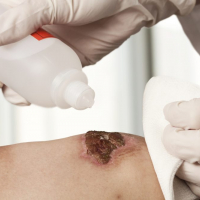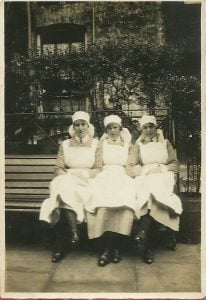
This blog for nurses looks at Cochrane evidence on antibiotics and antiseptics for wounds and finds that there is a lack of reliable evidence to inform practice.
So here I am again, writing about evidence and pressure ulcers. These two things continue to be strangers to each other it seems! I pounced on a recent Cochrane review on antibiotics and antiseptics for pressure ulcers with the hope that we might have some good evidence to help us with some of the uncertainties around how best to treat them. It’s the latest in a suite of reviews, joining others on their use to treat surgical wounds healing by secondary intention and venous leg ulcers. Was my enthusiasm justified? Well let’s take a look at all of these.
Antibiotics and antiseptics for pressure ulcers

Are we any further on? We still idon’thave reliable evidence to inform practice
The reviewers looked for evidence from randomized controlled trials (RCTs) on the effects of systemic and topical antibiotics, and topical antiseptics, on pressure ulcer healing in any clinical setting. They found 12 relevant trials with 576 participants, all assessing topical agents: povidone iodine, cadexomer iodine, gentian violet, lysozyme, silver dressings, honey, pine resin, polyhexanide, silver sulfadiazine, and nitrofurazone with ethoxy-diaminoacridine. They were compared with alternative antimicrobials or other ointments and dressings.
They found that there was no consistent evidence of a benefit to using any particular treatment for pressure ulcers. The reviewers note that there was some indication that more ulcers healed when treated with some types of dressings without antimicrobial properties than with povidone iodine, but this needs to be addressed by better trials.
Disappointingly, this leaves us no further on, other than (and this is important) understanding that here we have an evidence gap. None of the evidence in this review is high quality. Studies were small and reported so poorly that they don’t further our knowledge here. Yet these are choices being made every day by nurses, and those who purchase treatment products, affecting the health of enormous numbers of people. What a waste!
What’s the evidence for their use for venous leg ulcers?
The authors of the review exploring this note that whilst clinical and prescribing guidelines state that antimicrobial therapy should only used in cases of confirmed clinical infection, it appears that they are widely used to manage chronic wounds, regardless of the presence of infection. Although the review includes 45 RCTs with 4486 participants, many were small and the evidence unreliable, leading the reviewers to conclude that “the role of systemic and topical antibiotics and topical antiseptics in managing venous leg ulcers remains poorly understood”.
So do they work for surgical wounds?
The Cochrane review exploring the effectiveness of antibiotics and antiseptics for surgical wounds healing by secondary intention (SWHSI) reaches similar conclusions to the pressure ulcer review. There is no robust evidence on the relative effectiveness of any antiseptic, antibiotic or antimicrobial for SWHSI.

Barts nurses (date uncertain). Photo from the private collection of Peter Maleczek, with permission
The review includes 8 RCTs with 886 participants, evaluating a range of comparisons and, once again, studies tended to be small and poorly reported. My eyes widened when I read that one study, from as recently as 2005, compared gauze soaked with either honey or EUSOL! Both very much in favour when I was doing my nurse training but I thought we’d come to a state of enlightenment about EUSOL a long while back. For the younger ones amongst you, EUSOL , or Edinburgh University Solution of Lime, was an antiseptic composed of chlorinated lime and boric acid, used for wound care throughout much of the last century. Research published in 1985 showing that EUSOL impaired blood flow in granulation tissue saw its use decline, but it was as late as 2008 thatNICE stipulated do not use EUSOL and gauze to manage surgical wounds that are healing by secondary intention.
Florence Nightingale herself, who knew a thing or two about managing wounds, in her contribution to the sanitary history of the British Army (as cited in Gill and Gill, 2005) said that “the three things which all but destroyed the army in Crimea were ignorance, incapacity and useless rules”. I think she’d be shocked at how ignorant we continue to be about some very basic aspect of managing wounds and promoting healing.
On a side note, do useless rules still exist in nursing? I was part of a conversation on social media recently with other former Barts nurses recalling all sorts of rules, like having to ensure pillow openings faced away from the door and turning patterned quilts to face the head or foot of the bed according to the time of day. Does ritual appear in modern day nursing practice? Now wouldn’t this make a good blog… Any offers?!
Read more in the Evidence for Everyday Nursing series here
Sarah Chapman has nothing to disclose.

Antibiotics and antiseptics for wounds: evidence and ignorance by Sarah Chapman is licensed under a Creative Commons Attribution-NoDerivatives 4.0 International License.
Based on a work at http://www.cochranelibrary.com. The stock images have been purchased from istock.com for Evidently Cochrane and may not be reproduced.
Links:
Norman G, Dumville JC, Moore ZEH, Tanner J, Christie J, Goto S. Antibiotics and antiseptics for pressure ulcers. Cochrane Database of Systematic Reviews 2016, Issue 4. Art. No.: CD011586. DOI: 10.1002/14651858.CD011586.pub2.
O’Meara S, Al-Kurdi D, Ologun Y, Ovington LG, Martyn-St James M, Richardson R. Antibiotics and antiseptics for venous leg ulcers. Cochrane Database of Systematic Reviews 2014, Issue 1. Art. No.: CD003557. DOI: 10.1002/14651858.CD003557.pub5
Norman G, Dumville JC, Mohapatra DP, Owens GL, Crosbie EJ. Antibiotics and antiseptics for surgical wounds healing by secondary intention. Cochrane Database of Systematic Reviews2016, Issue 3. Art. No.: CD011712. DOI: 10.1002/14651858.CD011712.pub2
NICE clinical guideline:
National Collaborating Centre for Women’s and Children’s Health; National Institute for Health and Care Excellence. Surgical site infection: prevention and treatment of surgical site infection. London: Royal College of Obstetricians and Gynaecologists; 2008. (NICE CG74). [Issued October 2008]. Available from:https://www.nice.org.uk/guidance/cg74
NICE ‘Do not do recommendation’:
National Institute for Health and Care Excellence. Do not do recommendation: do not use Eusol and gauze to manage surgical wounds that are healing by secondary intention. London: National Institute for Health and Care Excellence; 2008. (Guidance from: Surgical site infection – NICE CG74). Available from: https://www.nice.org.uk/donotdo/do-not-use-eusol-and-gauze-to-manage-surgical-wounds-that-are-healing-by-secondary-intention
Gill CJ, Gill GC. Nightingale in Scutari: her legacy re-examined. Clin Infect Dis 2005;40(12):1799-805. Available from: http://cid.oxfordjournals.org/content/40/12/1799.full.pdf+html
